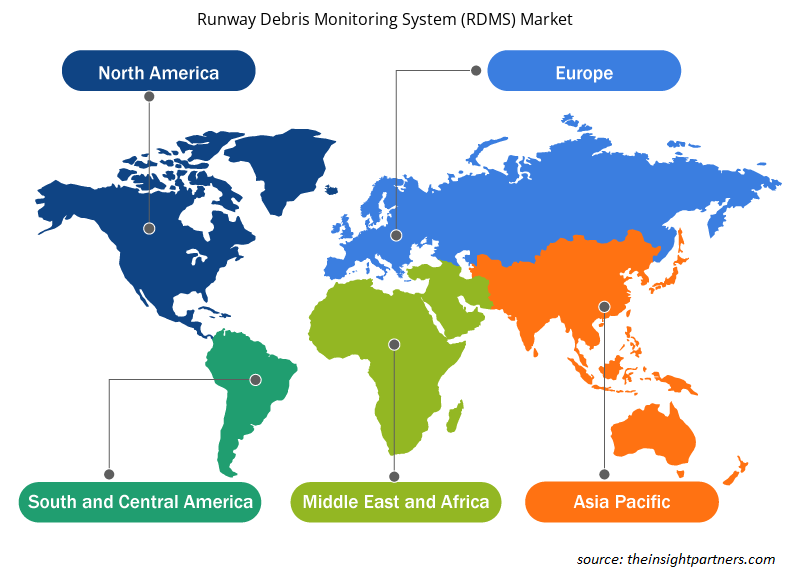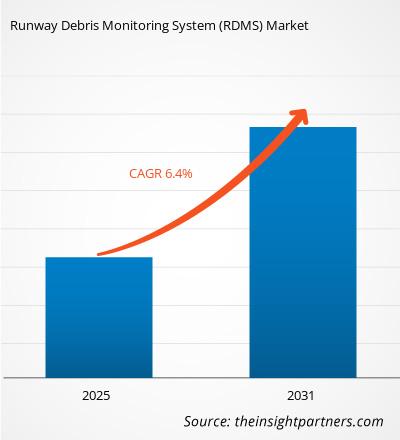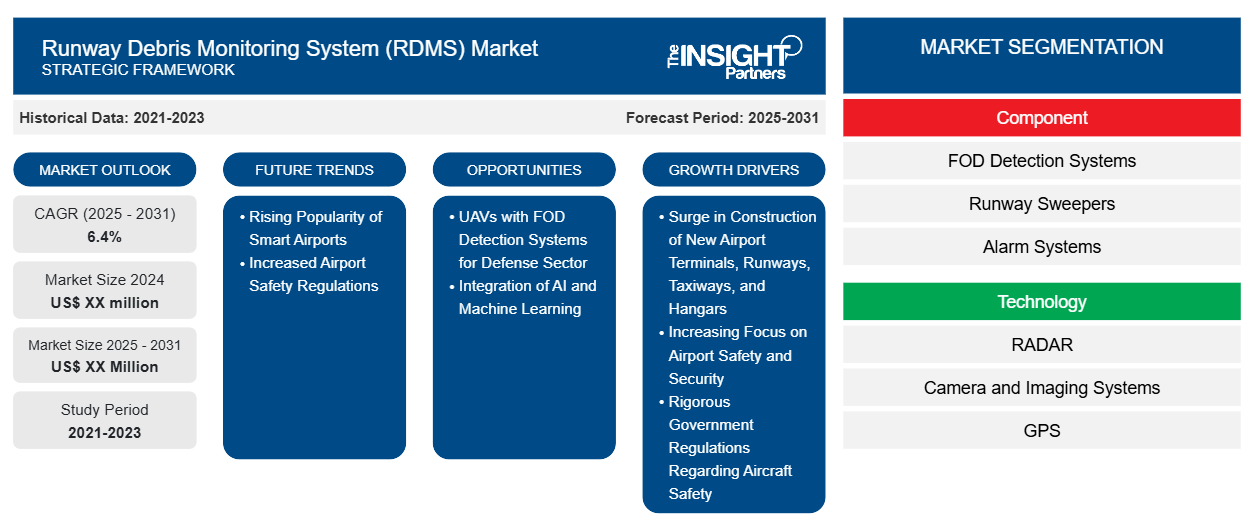滑走路残骸監視システム (RDMS) 市場は、2023 年から 2031 年にかけて 6.4% の CAGR を記録し、市場規模は 2023 年の XX 百万米ドルから 2031 年には XX 百万米ドルに拡大すると予想されています。
レポートは、コンポーネント(FOD検出システム、滑走路清掃車、警報システム、その他)、テクノロジー(レーダー、カメラおよび画像システム、GPS、レーザー、その他)、アプリケーション(検出、識別、リスク評価、除去、分析、その他)、プラットフォーム(固定、モバイル)別にセグメント化されています。グローバル分析は、地域レベルと主要国でさらに細分化されています。レポートは、上記の分析とセグメントに対してUSDでの価値を提供します。
報告書の目的
The Insight Partners によるレポート「滑走路残骸監視システム (RDMS) 市場」は、現在の状況と将来の成長、主な推進要因、課題、機会を説明することを目的としています。これにより、次のようなさまざまなビジネス関係者に洞察が提供されます。
- テクノロジープロバイダー/メーカー: 進化する市場の動向を理解し、潜在的な成長機会を把握することで、情報に基づいた戦略的意思決定が可能になります。
- 投資家: 市場の成長率、市場の財務予測、バリュー チェーン全体に存在する機会に関する包括的な傾向分析を実施します。
- 規制機関: 市場の濫用を最小限に抑え、投資家の信用と信頼を維持し、市場の完全性と安定性を維持することを目的として、市場における政策と警察活動を規制します。
滑走路デブリ監視システム (RDMS) 市場のセグメンテーション
成分
- FOD検出システム
- 滑走路清掃員
- 警報システム
- その他
テクノロジー
- レーダー
- カメラおよび画像システム
- GPS
- レーザ
- その他。
応用
- 検出
- 識別
- リスクアセスメント
- 除去
- 分析
- その他
プラットフォーム
- 修理済み
- 携帯
プラットフォーム
- 修理済み
- 携帯
要件に合わせてレポートをカスタマイズする
このレポートの一部、国レベルの分析、Excelデータパックなど、あらゆるレポートを無料でカスタマイズできます。また、スタートアップや大学向けのお得なオファーや割引もご利用いただけます。
-
このレポートの主要な市場動向を入手してください。この無料サンプルには、市場動向から見積もりや予測に至るまでのデータ分析が含まれます。
滑走路残骸監視システム (RDMS) 市場の成長要因
- 新しい空港ターミナル、滑走路、誘導路、格納庫の建設の急増:世界的な商用航空機艦隊の増加は、世界中で増加する旅客交通量に対応するために、さまざまな空港で新しいフライト、ターミナル、滑走路、格納庫の需要を生み出す主な要因の1つです。これにより、空港当局は、膨大な数の航空機に対応できるようにそれぞれの空港施設をアップグレードするための投資を促進し、空港全体の運用効率も向上します。2021年5月、関西国際空港(KIX)は、年間約4,000万人の国際旅客の管理に重点を置いた拡張プロジェクトを開始しました。このプロジェクトは、関西で開催される2025年大阪万博までに完了する予定です。このように、新しい空港ターミナル、滑走路、誘導路、格納庫の建設は、滑走路デブリ監視システム市場の成長に貢献しています。
-
空港の安全とセキュリティへの注目の高まり: 滑走路上の異物破片 (FOD) による安全リスクへの懸念が高まる中、空港と航空当局は高度な破片監視システムに投資しています。滑走路での事故を防ぎ、運用効率を改善し、より厳しい安全規制に準拠する必要性から、これらのシステムの需要が高まっています。
航空機の安全性に関する厳格な政府規制: FOD (異物破片) の存在は、空港での継続的な懸念事項です。連邦航空局 (FAA) は、空港滑走路異物破片 (FOD) 検出システムの製造と調達に関するガイドラインを示しました。すべての顧客と製造者は、FOD 検出システムの入手と製造に関して FAA が設定した基準に従う必要があります。航空会社、空港、および一般航空コミュニティは、AC 150/5210-24 に従い、効果的な FOD 管理プログラムに参加することで、FOD を最小限に抑えるための重要な措置を講じています。 FAA 異物破片プログラムの回覧文書、例えば AC 150/5210-24、空港異物破片 (FOD) 管理では、FOD を、空港環境内の不適切な場所にある、生きているかどうかに関わらず、空港や航空会社の職員に危害を与えたり、航空機に損傷を与えたりする可能性のあるあらゆる物体と定義しています。したがって、航空機の安全性に関する厳格な政府規制が、滑走路破片監視システム市場を牽引しています。
滑走路デブリ監視システム (RDMS) 市場の将来動向
- スマート空港の人気の高まり: 政府当局がスマート空港に傾倒する傾向が強まるにつれ、空港敷地内でのスマート システムの実装に対する需要が高まっています。米国、英国、中国などの先進国の政府は、リアルタイム情報への関心が高まり、空港運営における高度な接続技術に対する需要が高まっているため、通信およびネットワーク システム、スマート センサー、カメラ、RFID タグ、ウェアラブルなどのスマート空港技術を活用しています。したがって、スマート空港への注目が高まることで、予測期間中に滑走路デブリ監視システム市場の成長に有利な機会が生まれると予想されます。
- 空港の安全規制の強化: 世界中の航空当局が安全基準を厳しくするにつれ、コンプライアンス要件を満たす高度な破片監視システムの機会が拡大しています。空港は、滑走路の安全を確保し、異物破片 (FOD) によるコストのかかる遅延や事故を回避するために、新しいテクノロジーに投資するでしょう。
滑走路デブリ監視システム (RDMS) の市場機会
- 防衛分野向けFOD検出システムを備えたUAV:監視、戦闘作戦、輸送と配達、戦闘被害管理などの用途で軍人による無人航空機(UAV)の導入が増加しています。たとえば、2024年5月、SkyLark LabsはMercedes-Benz India Pvt. Ltd.と協力し、人工知能(AI)駆動型モバイル異物デブリシステムを活用しました。FOD検出システムは、主にiDEX Defence Innovation Organizationの下でインド海軍向けに開発されました。この高度なソリューションは高度な自己学習能力を備えており、パフォーマンスを継続的にアップグレードし、変化するFODの状況に応じて修正することができます。したがって、防衛分野向けのUAVとFOD検出システムの統合は、今後数年間で滑走路デブリ監視システム市場に新たなトレンドをもたらすと予想されます。
- AI と機械学習の統合: 最新の滑走路破片監視システムでは、破片のリアルタイム検出と分析を強化するために、AI と機械学習アルゴリズムがますます取り入れられています。これらのテクノロジーは、潜在的な脅威を迅速に特定し、対応時間を短縮し、空港の安全プロトコルを改善するのに役立ちます。
滑走路デブリ監視システム (RDMS) 市場の地域別分析
予測期間を通じて滑走路残骸監視システム (RDMS) 市場に影響を与える地域的な傾向と要因は、Insight Partners のアナリストによって徹底的に説明されています。このセクションでは、北米、ヨーロッパ、アジア太平洋、中東およびアフリカ、南米および中米にわたる滑走路残骸監視システム (RDMS) 市場のセグメントと地理についても説明します。

- 滑走路デブリ監視システム(RDMS)市場の地域別データを入手
滑走路デブリ監視システム(RDMS)市場レポートの範囲
| レポート属性 | 詳細 |
|---|---|
| 2023年の市場規模 | XX百万米ドル |
| 2031年までの市場規模 | XX百万米ドル |
| 世界のCAGR(2023年~2031年) | 6.4% |
| 履歴データ | 2021-2022 |
| 予測期間 | 2024-2031 |
| 対象セグメント |
コンポーネント別
|
| 対象地域と国 |
北米
|
| 市場リーダーと主要企業プロフィール |
|
滑走路デブリ監視システム(RDMS)市場のプレーヤー密度:ビジネスダイナミクスへの影響を理解する
滑走路残骸監視システム (RDMS) 市場は、消費者の嗜好の変化、技術の進歩、製品の利点に対する認識の高まりなどの要因により、エンドユーザーの需要が高まり、急速に成長しています。需要が高まるにつれて、企業は提供を拡大し、消費者のニーズを満たすために革新し、新たなトレンドを活用し、市場の成長をさらに促進しています。
市場プレーヤー密度とは、特定の市場または業界内で活動している企業または会社の分布を指します。これは、特定の市場スペースに、その市場規模または総市場価値に対してどれだけの競合相手 (市場プレーヤー) が存在するかを示します。
滑走路残骸監視システム (RDMS) 市場で事業を展開している主要企業は次のとおりです。
- ナブテックレーダー
- キネティQ
- タレスグループ
- ムーグ株式会社
- ラインメタルAG
免責事項:上記の企業は、特定の順序でランク付けされていません。

- 滑走路残骸監視システム(RDMS)市場のトップキープレーヤーの概要を入手
主なセールスポイント
- 包括的なカバレッジ: レポートでは、滑走路残骸監視システム (RDMS) 市場の製品、サービス、タイプ、エンドユーザーの分析を包括的にカバーし、全体的な展望を提供します。
- 専門家による分析: レポートは、業界の専門家とアナリストの深い理解に基づいてまとめられています。
- 最新情報: このレポートは、最新の情報とデータの傾向を網羅しているため、ビジネスの関連性を保証します。
- カスタマイズ オプション: このレポートは、特定のクライアント要件に対応し、ビジネス戦略に適切に適合するようにカスタマイズできます。
したがって、滑走路デブリ監視システム (RDMS) 市場に関する調査レポートは、業界のシナリオと成長の見通しを解読して理解する道の先導役となる可能性があります。いくつかの正当な懸念があるかもしれませんが、このレポートの全体的な利点は欠点を上回る傾向があります。
- 過去2年間の分析、基準年、CAGRによる予測(7年間)
- PEST分析とSWOT分析
- 市場規模価値/数量 - 世界、地域、国
- 業界と競争環境
- Excel データセット
最新レポート
お客様の声
購入理由
- 情報に基づいた意思決定
- 市場動向の理解
- 競合分析
- 顧客インサイト
- 市場予測
- リスク軽減
- 戦略計画
- 投資の正当性
- 新興市場の特定
- マーケティング戦略の強化
- 業務効率の向上
- 規制動向への対応























 無料サンプルを入手 - 滑走路デブリ監視システム(RDMS)市場
無料サンプルを入手 - 滑走路デブリ監視システム(RDMS)市場